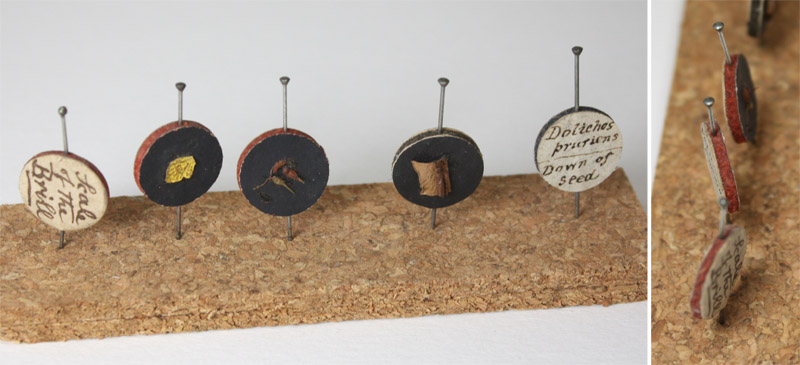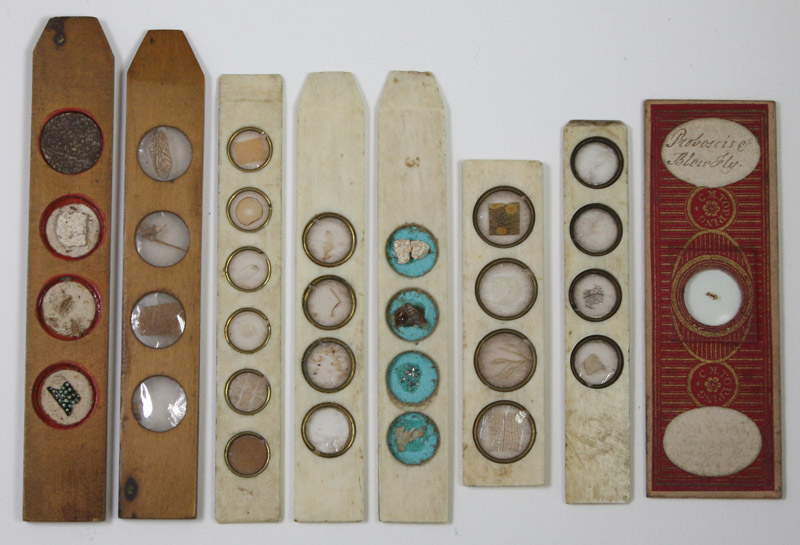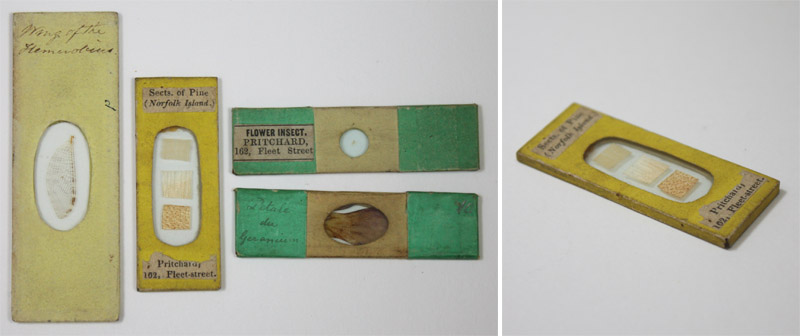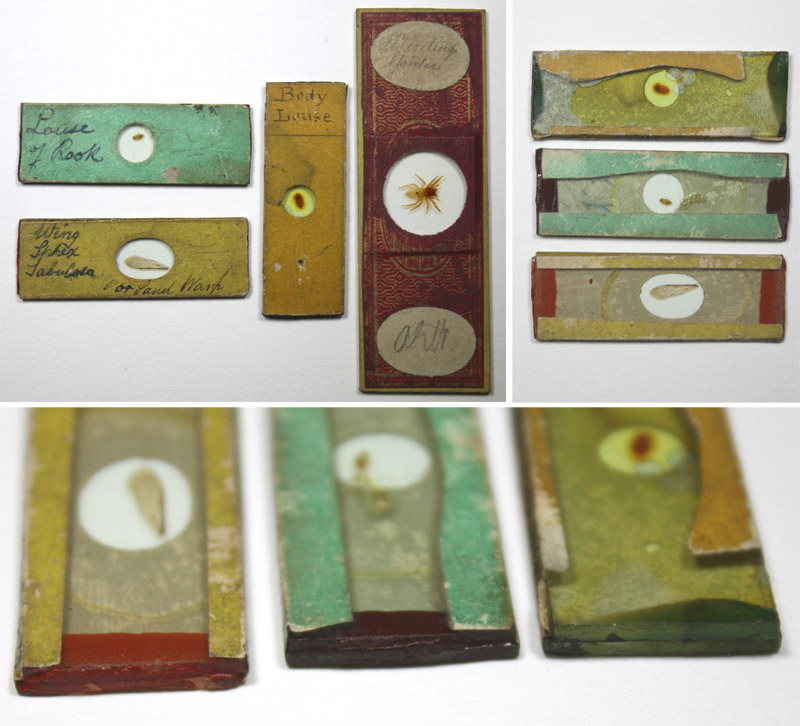
Figure 1. Examples of opaque specimens ”fastened upon circular discs … then transfixed with fine pins”. A description of each specimen is written on the reverse. The discs are approximately 1/2 inch / 1 cm in diameter.
1843: “On the Different Modes of Preserving
Microscopic Objects”
by Brian Stevenson
last updated September, 2021
The following article was written by John William Griffith in July, 1843, and published in The Annals and Magazine of Natural History, volume 12, pages 113-117. The original article did not include illustrations, modern figures have been added to show examples of mounting methods described in the article. Please note that the pictures are shown as style examples only, there are no reasons to assume that Griffith produced any of the illustrated preparations.
J.W. Griffith (born 1819, died 1901), was a physician and Fellow of the Linnaean Society. He wrote numerous books and articles, including the 1856 Micrographic Dictionary, which was coauthored with Arthur Henfrey. A full biographical essay of Griffith's life and works is on another page of microscopist.net.
Griffith’s article provides important insight on the state of microscope object preparation in 1843, and are useful to help date slides and other specimens. Key points include:
Several of the recommended techniques would not yield long-lasting slides, so ca. 1843 examples of such preparations are likely to be rare or nonexistent today.
__________________________________________________
“On the different modes of preserving Microscopic Objects”
By John Wm. Griffith, M.D., F.L.S. &c.
During the progress of microscopic experiments and examinations, we are continually meeting with parts in which some peculiar structure is particularly well illustrated, which we are anxious to preserve; sometimes, for the purpose of reference and comparison, we are obliged to keep specimens of different structures by us. It is my intention here to say a few words on the best methods of so doing.
The description of these is no slight task, for it is by no means easy to render a clear account of the manipulations required, so as to make them applicable by others; moreover, one in the habit of continually putting up specimens is apt to overlook mentioning certain minutiae, which, from use, he is hardly aware of performing, but which are essential to the perfection of the work. The main point is to protect the object from injury by surrounding influences, such as violence, the action of the preservative liquids, evaporation, &c. This in a few cases is impossible, but in the majority any alterations produced in those specimens which are properly put up are so slight as not to destroy their value. There are two modes of viewing microscopic objects; one when illuminated by reflected, the other by transmitted light. I shall first notice the former.
Opake (sic) objects are of two kinds; those preserved in the dry, and those in the moist state.
A. The dry ones are usually fastened upon circular discs, or columns of cork, by a little gum, or solution of gum mixed with isinglass; they are then transfixed with fine pins, so as to be stuck into cork, which forms the bottom of the drawer in which they are arranged. Sometimes the circular flat discs of cork are fastened upon glass slips, and arranged in cabinets in the same manner as transparent objects. The cork must always be blackened, so as to prevent the reflection of any luminous rays which might interfere with the distinct vision of the object. This is effected in cork either by scorching or painting it over with an intimate mixture of finely powdered lamp-black and gum-water. But almost any black surfaces may be used for this purpose—black velvet, silk, paper, or blackened metal. When the opake object is illuminated (and which is the best way) by the condensation of light by a plano-convex or other lens, the size of the cork or other support for the object is of no consequence. But when the light is first reflected by the mirror and subsequently condensed by a second concave metallic mirror or cup, of course the smaller the object-holder is, the better, because it allows a larger number of rays to be condensed and to illuminate the object more perfectly.

Figure 1.
Examples of opaque specimens ”fastened upon circular
discs … then transfixed with fine pins”. A description of each specimen is
written on the reverse. The discs are approximately 1/2 inch / 1 cm in
diameter.

Figure 2.
Examples of opaque specimens “fastened upon glass
slips”. In these examples, the specimens were glued onto circles of black
paper. Both slides are approximately 2 x 1/2 inches in size.
B. Those which, although viewed as opake objects, are yet preserved liquid, are kept in cells, which will be presently described; many animal preparations, injections, &c. are best preserved in this manner.
Transparent Objects. - Different methods from those usually adopted were formerly made use of to prepare these. They were laid upon slides of various kinds, ivory, wood, or glass. The ivory ones (which are scarcely ever now used), of various sizes, had circular apertures turned in them at regular distances; in these holes small discs of talc were laid; they were prevented from falling through these holes by an elevated rim left at one end, so that the aperture was larger at one end than at the other; on the other side they were prevented from escaping by the pressure of a small brass ring (cut from off a spiral coil). These, as I have said, are now rarely used, on account of the expense of the turned ivory, the difficulty in arranging the objects nicely, as well as the obvious objections to the talc. The wooden ones are abandoned for nearly the same reasons.

Figure 3.
Examples of ivory and wood slides, which Griffith described as being out of fashion in 1843. A circa 1860s 1x3 inch glass slide by Charles Topping is shown for size comparison.
They are now generally made of glass. A number of oblong glass slips of the same size1 are usually kept already cut, and washed clean with soap and water to free them from grease, &c. Many vegetable preparations can be beautifully preserved by placing them between two of these glass slips, next tying the latter together towards each end by a turn or two of cotton or fine string, then keeping them immersed in a wide-mouthed stoppered bottle containing spirits of wine and water. Those only are well kept thus which are used with low powers of the microscope. When required to be examined they are taken out, drained and wiped; enough spirit usually remains between the glasses by capillarity to insure their transparency.
To preserve transparent objects dry, if low powers only be used, they may be laid between two of the above-mentioned slips, allowed perfectly to dry (if previously moist), and the whole slide covered with a doubled piece of pasted coloured paper, excepting two circular or other shaped apertures corresponding to the site of the objects.

Figure 4.
Examples of “transparent objects dry … laid between two
… slips, … and the whole slide covered with a doubled piece of pasted coloured
paper, excepting two circular or other shaped apertures corresponding to the
site of the objects”. The left panel shows a standard sized (1x3 inch) slide
that was probably made by C.M. Topping, sections of pine wood retailed by
Andrew Pritchard (maker unknown) and two slides made by Joseph Bourgogne (one
of which was retailed by Pritchard).
In some cases where the objects are not quite so transparent as we should wish - in, I may say, all cases of the preservation of crystalline bodies, particularly when for examination by polarized light - they may be immersed in Canada balsam. For low powers take two glass slips, having heated one gently over the spirit-lamp (at a great distance however); place upon it a small quantity of Canada balsam from the end of a piece of stick. Let this perfectly, but slowly, melt and diffuse itself over the glass; now lay in its centre the object; if necessary, drop a small quantity more of the balsam upon it, and then lay the other previously warmed glass slide upon the first; gently press them together: should any balsam exude at the edges of the glass plates, remove this by a slip of card; allow the balsam to solidify; the whole is then completed. Should any of the balsam have escaped upon or smeared the surfaces of the glass so as to destroy the transparency of the object, a little oil well rubbed in will remove it; alcohol will produce the same effect, but it is apt to act upon the balsam between the glasses and injure the specimen, which oil does not. I may remark here, that the longer the balsam is heated over the lamp or candle, the sooner it solidifies after removal from it. I generally therefore continue to heat the balsam, so that there is no fear of the glass slips moving upon one another so as to injure the object. But it requires great care to avoid the extrication of air-bubbles. In many cases it is convenient to fasten the two ends of the glass slips together whilst the balsam is solidifying, so as to insure the avoidance of displacement: this can be done by a little sealing-wax, or what is better, “marine glue2.” Venetian turpentine may be used instead of Canada balsam, and it solidifies much more rapidly, but it is neither so transparent nor so readily managed.

Figure 5.
Three examples of specimens “immersed in Canada balsam .. (between) two glass slips”. Griffith recommended that, “In many cases it is convenient to fasten the two ends of the glass slips together whilst the balsam is solidifying, so as to insure the avoidance of displacement: this can be done by a little sealing-wax”. The three illustrated slides were similarly secured with two shades of red wax and one of green (upper right and the lower panel). A ca. 1870s standard sized (1x3 inch) slide made by Amos Topping is shown in the upper left panel as a size comparison. The ca. 1843 slides measure approximately 2 x 1/2 inch.
A large number of the most beautiful and delicate objects cannot be preserved in the dry way, the shrivelling and contraction which ensue totally destroying the natural appearance. These are best kept in a small cell containing a liquid, which must be prevented from evaporating. The liquids mostly used are, syrup mixed with gum, dilute spirit, water saturated with creasote, or the fluid invented by Mr. Goadby, and which is the best. It is thus made: take 4 oz. of bay salt, 2 oz. of alum, 4 grs. of corrosive sublimate, and 2 qts. of boiling water; these must be well stirred together, and filtered through fine filtering paper. This is an excellent composition for preserving animal and vegetable substances, and has less action upon them than any of the other fluids. The spirit or water and creasote corrugate the preparations so as in many cases entirely to destroy their characteristic appearances, and the syrup has a powerful exosmotic action, which collapses all vesicular preparations. There are two methods of forming the cells here: in the first a varnish is used to inclose the liquid; in the second a wall is formed to the cell, of glass, &c.
A quantity of very thin glass (from the 1/100th to the 1/500th of an inch) must be procured3, and cut into square or oblong pieces of various sizes, according to that of the thick glass support, which, for the sake of avoiding repetition, I shall call the base of the specimen. The thin glass should not be longer than is absolutely necessary, so as to avoid the risk of its being broken. The base is now wiped perfectly dry and clean, the object laid on its centre; a small quantity of the preservative liquid is next dropped on it; upon this is laid the thin glass square, wiped perfectly clean: should the quantity of liquid added be not sufficient to fill the whole space between the two glasses, a little more must be added4 until such is the case; if too much has been added, it may be readily removed by a fine pipette, camel-hair pencil, or moistened piece of blotting paper. When the surfaces of both glasses, not in apposition, are quite free from moisture, some gold size thickened by intimate mixture with lamp-black must be laid all round the edges of the thin glass, partly also upon the contiguous portions of the lower, so as to hermetically inclose the liquid and the object. The mixture of the finely-powdered lampblack and the gold size (the latter of which ought to be old) should be about the consistency of treacle, or rather less. If made too thin, it is apt to run in under the upper glass and destroy the specimen.
When the objects are large, the following mode is generally adopted. A circular depression is excavated in the substance of the basic slip, which is double or treble the ordinary thickness, and in this the object and the liquid are placed; these are then covered with thin glass, and the gold size and lamp-black applied as above around the edges of the latter. Or a square piece of thick crown glass, less in size than the breadth of the basic slip, has either a circular or square hole drilled through it; this is next fastened to the base either by Canada balsam or varnish; a cell is thus made in which the object and liquid are placed; the thin glass slip is next applied upon the upper surface of the excavated piece; it is then covered at the edge, and rendered adherent to it by the gold size and lamp-black.
Another method is this. Take a basic slip of glass, and spread a little white lead ground up with oil (or painter’s white paint) on its upper surface, leaving an aperture in the middle to receive the object. This requires to be painted over and over until it has become of the thickness of the specimen to be preserved; the blank space or cell is next filled with one of the preservative liquids, and the object then immersed in it; a slip of thin glass is now laid upon the surface of the white lead and rubbed close on to the paint, beginning at one end and passing across the slide to the other, so as to force out any air-bubbles. When dry the specimen is permanent. These will, I think, be found sufficient for the preservation of almost any objects ; there are, however, a few which it is very difficult to retain perfect. Many I have preserved simply by leaving them to dry between two slips of glass, without any preservative fluid or balsam. Blood-discs, &c. have kept remarkably well in this manner; but we can place no dependence on so doing, for one which is good perhaps there are twenty spoiled. Talc was formerly used instead of thin glass to cover objects, but it is very objectionable on account of its being so readily scratched, the difficulty of procuring it free from flaws, and its peculiar effect in polarizing light. There is only one circumstance more worthy of mention, and which is very common but very injurious: it is the placing too much of an object on a slide at once; this often renders a beautiful object of little value. I need hardly say that it is better, if possible, to preserve most specimens under thin glass, so that at any future time they can be examined by the high powers of the microscope, if necessary.
9 St. John’s Square, July 21, 1843
Griffith’s Footnotes:
1. This varies according to the whim of different observers, but the thickness is best about that of ordinary window glass.
2. It is thus made: dissolve 1 lb. of caoulchouc in 4 gallons of coal naphtha by maceration for several days, and with 1 pint of this solution, 2 lbs. of shellac are to be mixed by heat; and when the fusion is completed, the material is to be poured out on a cold slab and moulded into convenient forms, and used as sealing-wax.
3. This can be obtained at any optician’s.
4. On the end of a camel-hair pencil or pen; it will run in by capillary attraction.